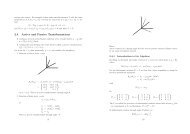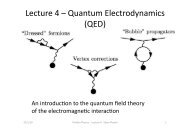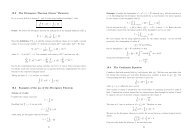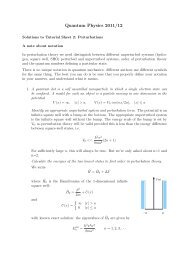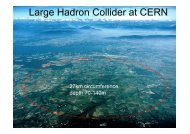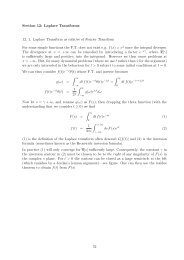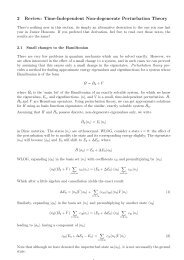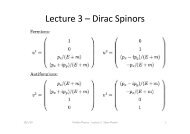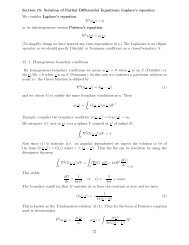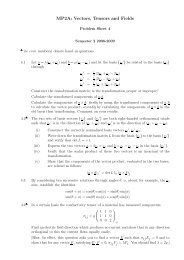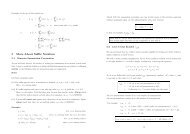Solutions to Tutorial Sheet 1: Mainly revision 1. Given the expansion ...
Solutions to Tutorial Sheet 1: Mainly revision 1. Given the expansion ...
Solutions to Tutorial Sheet 1: Mainly revision 1. Given the expansion ...
Create successful ePaper yourself
Turn your PDF publications into a flip-book with our unique Google optimized e-Paper software.
4. At t = 0, a particle has a wavefunction ψ(x, y, z) = A z exp[−b(x 2 + y 2 + z 2 )], whereA and b are constants.(a) Show that this wavefunction is an eigenfunction of ˆL 2 and of ˆL z and find <strong>the</strong> correspondingeigenvalues. Hint: express ψ in spherical polars and use <strong>the</strong> sphericalpolar expressions for ˆL 2 and ˆL z .ˆL 2 = −¯h 2 [ 1sin θˆL z = −i¯h ∂∂φ(∂sin θ ∂ )+ 1∂θ ∂θ sin 2 θFirst note that x 2 + y 2 + z 2 = r 2 and z = r cos θ, so thatu(r, θ, φ) = Ar cos θ exp(−br 2 )∂ 2 ]∂φ 2In spherical polars,ˆL 2 = −¯h 2 [ 1sin θ(∂sin θ ∂ )+ 1∂θ ∂θ sin 2 θ∂ 2 ]∂φ 2Since u is actually independent of φ, we can ignore <strong>the</strong> second term when we apply ˆL 2<strong>to</strong> <strong>the</strong> wavefunction u and note that1 ∂(sin θ ∂ )sin θ ∂θ ∂θ cos θ = 1 ∂ (− sin 2 θ ) = −2 cos θsin θ ∂θThusˆL 2 u(r, θ, φ) = 2¯h 2 Ar cos θ exp(−br 2 ) = 2¯h 2 u(r, θ, φ)so that u(r, θ, φ) is an eigenfunction of ˆL 2 with eigenvalue 2¯h 2 . Writing 2¯h 2 = l(l+1)¯h 2 ,we see that <strong>the</strong> orbital angular momentum quantum number l = <strong>1.</strong>We have already noted that u(r, θ, φ) is independent of φ which tells us immediatelythat it is an eigenfunction of ˆL z belonging <strong>to</strong> eigenvalue m = 0. Explicitly, we notethat in spherical polar coordinates,ˆL z = −i¯h ∂∂φso that ˆL z u(r, θ, φ) = 0. A short cut <strong>to</strong> <strong>the</strong> answer is <strong>to</strong> note that u(r, θ, φ) ∝ Y 10 (θ, φ)and hence l = 1 and m = 0.(b) Sketch <strong>the</strong> wavefunction, e.g. with a con<strong>to</strong>ur plot in <strong>the</strong> x=0 plane.The function is zero at <strong>the</strong> origin. It has positive and negative lobes pointing aong<strong>the</strong> z-axis, decaying away <strong>to</strong> zero far from <strong>the</strong> origin. In fact, it looks a bit like ahydrogenic p-orbital (l = 1), though it isn’t quite <strong>the</strong> same.8



